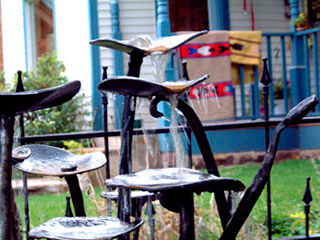 “STEELWORKS Three Artisans Turn Metal Into Artwork”
“STEELWORKS Three Artisans Turn Metal Into Artwork”
by Elizabeth Covington
Shelter Magazine, A Watch Newspaper publication
April 2004
“Functional art.” “Custom functional designs.”
These are the words steel artist Lisa Issenberg uses to describe her work.
“Form follows function,” says Issenberg, quoting architect Louis Sullivan. Issenberg, in her loft studio in East Ophir, is surrounded by the tools of her trade. A computer and printer, along with sketch paper and pens, sit on one end of a desk. On the other end are jewelry tools, a mini drill press, special German manufactured pliers and others, and behind her are shelves filled with various containers holding felt, sewing thread and measuring tape. Her steel working tools are in a cabin in her backyard.
In addition to being a functional steel artist, Issenberg has made a name for herself as a jeweler, photographer and textile artist. Her jewelry—playful combinations of silver and black and white photography—is exhibited at the Telluride Gallery of Fine Art. One of her public art pieces is a black and white banner that hangs in the Telluride Conference Center.
The steel garbage cans that mark the corners of Telluride’s streets, however, are perhaps what most embody Issenberg’s form-follows-function philosophy. The top openings are closed off against raiding animals and the sides are decorated with cutouts of mountains that are inset with black and white photographs.
“I work with each client to find out what they need functionally,” says Issenberg. And after considering the function she designs an aesthetic form to compliment the purpose of the piece.
One client, for instance, wanted a fountain for her town-sized garden that is landscaped with natural forms, rocks, bushes and native plants.
“It seemed like the metal needed to take on an organic form so it would fit in,” explains Issenberg. And, as in many cases when clients ask her to propose a design, she developed several different options.
“I usually propose different ideas and themes, which are often playful, colorful and whimsical.”
The result: thirteen lily pads arranged in varying heights so that the water runs from one lily pad to the next, touching each on its return to the pool. The lily pads are forged out of metal that will rust and blend with the earth tones in the existing landscape. The water circulates through tubing in the stems of three lily pads.
